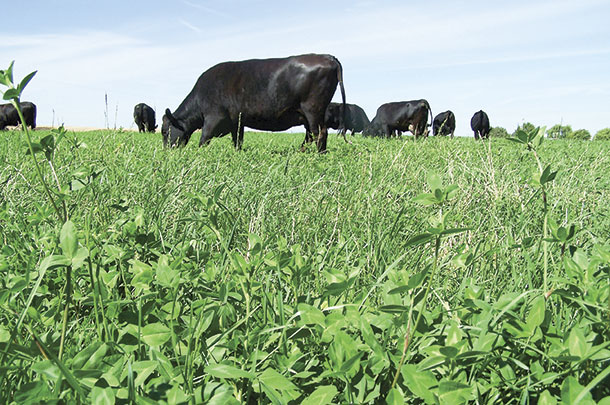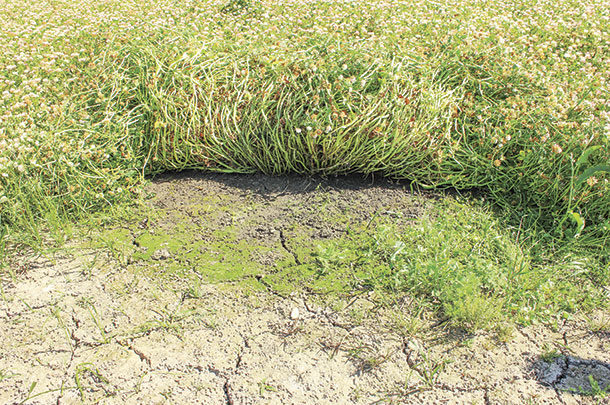For the last 25 years, Keith and his brother, Brian, have been farming 2,000 acres of irrigated dryland in south-central Nebraska, transitioning the cereal rotation to no-till 12 years ago, along with incorporating cover crops. This led to the brothers founding Green Cover Seed in 2009 to bring more cover crop opportunities to their farm and fellow operations.
“Whether you’re a livestock producer grazing pasture and growing your own homegrown feedstuffs, or a row crop farmer selling off cereals as a commodity, there is one main thing you both have in common, and that’s the importance of healthy soil to set a crop up to reach its potential,” Keith says.

To understand and simplify the complicated components to soil science, Keith likes to parallel it to the six components of the economy to a country, which he calls “carbonomics.”
Supply and demand
Economies are strongest when a high percentage of all the entities within the economy are producing something, says Keith. In the field, the plants and soil serve as the entities.
“Plants produce carbon through photosynthesis and also provide protective services for the soil,” Keith says. “The soil provides mineral nutrients, habitat for roots and biology, and water storage. The biology provides nutrients through fixation and cycling as well as protective services.”
Currency
When someone has a fist full of cash, they can go out and buy things, says Keith. When plants are planted, farmers are growing their soil’s currency.
“Carbon is the perfect currency in the soil economy as it can be produced with photosynthesis, spent or traded through root exudates, stored in savings as organic matter and is desired by all. Carbon, like any good currency, also has multiple forms (gas, liquid and solid) and can transform very easily from one to another. Utilizing cover crops whenever possible will help you increase your cash flow of carbon currency for maximum production.”
Capital
When it comes to money in the bank, capital is the stored currency in the field which will allow for long-term stability.
“Stored carbon currency is held in the soil as organic matter and is one of the most important indicators of a healthy soil. High organic-matter soils, like capital-rich economies, are very productive, stable, resilient and efficient. Soil organic matter cannot be increased without having excess carbon in the soil, and cover crops are one of the best ways to increase soil carbon.”
Energy and resources
Energy drives the system, but it’s often expensive, Keith says, and resources supply the base in which we can expand and grow our economies. “Soil economies are all solar-powered – really, what we are doing is capturing sunlight and producing something with it.
As farmers, we need to plant seeds and grow our own solar collectors. Resources for our economy include carbon (free from photosynthesis), nitrogen (free from biological fixation) and other soil minerals which are ‘mined’ by the soil biology and ‘sold’ to the plant in exchange for carbon. Promoting soil biology is like hiring trillions of tiny workers to mine, manufacture, transport and deliver plant-needed resources.”
Infrastructure
Infrastructure allows economies to grow beyond subsistence level but needs communication and transportation to be successful.
“A plant root is like an interstate highway because they’re big conduits to transport large amounts of goods and services from the plant, which is a carbon-producing factory. It will then transport the carbon throughout the soil where it can be spent or traded to soil organisms,” Keith says. “Mycorrhizal fungi, earthworms and other soil biology are the primary transportation mechanisms in the soil. Sophisticated communication also occurs at multiple levels between plants and soil biology.”
Defense and protection
Keith says an economy must be defended and protected from those wanting to consume without producing, or the system will become unbalanced.
“In the field, there are many things we must protect against that can wreck the whole system, like drought, floods, wind, heat, cold, compaction, weeds and insects,” he says. “To provide protection, soil needs cover. If you don’t have soil cover, nothing else you do will really work – always aim for full soil coverage. And in order for all the other carbonomic components to work, like infrastructure and currency, soil must be protected.” ![]()
PHOTO 1: Without protection, the other carbonomic components of soil would not be able to function, says Keith Berns of Green Cover Seed. The deep taproot system in this cold-tolerant variety of balansa clover not only improves soil structure and creates nutrient channels for the next crop, but provides full soil coverage during drought conditions.
PHOTO 2: When used in permanent pasture as forage applicators, cover crops can provide livestock with a high-quality feed source while giving pasture a production boost through soil improvement, says Jerry Hall, director of research for Grassland Oregon. Photos provided by Laura Mushrush.
Laura Mushrush is a freelancer with Agribusiness Communications. Email Laura Mushrush.
Cashing in on cover crops
Extensive root systems reduce compaction and improve water filtration while burrowing nutrient channels deep into untouched soil. Added biomass adds tons of organic matter to soil and, when the right variety is planted, fix hundreds of pounds of free nitrogen per acre.
Whether being used in a crop rotation to maximize production with bonus homegrown feedstuff or utilized as a forage applicator to give permanent pasture an extra boost, livestock producers have a lot to gain above and below ground through the synergistic relationship between soil and cover crops.
“While we can manage some of the missing pieces with man-made inputs, we cannot replicate the synergy occurring in the soil between the microbes, bacteria, fungi and cover crops. When we quit utilizing cover crops in favor of sterile, fallow fields, we lost these beneficial relationships; entering a spiral of soil degradation that continually relies on increased inputs,” says Jerry Hall, director of research for Grassland Oregon.
“Adopting a more holistic approach and nurturing the soil cannot only improve your profitability, but also benefits future generations with healthier soils.”










